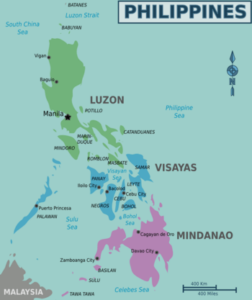Urban Land magazine is accepting nominations for the 2016 class of 40 Under 40, a program recognizing outstanding and talented land use professionals under the age of 40 from around the world. This month, ULI Connect profiles a member of the 40 Under 40 class of 2014, Karima Palafox, partner at Palafox Associates and Palafox Architecture Group, both based in Manila, Philippines.
An archipelago of more than 7,100 islands, the Philippines boasts one of the longest coastlines in the world—a boon to tourism and the economy as a whole. Yet this unique geography has also led to a politically fragmented nation where powerful local governments often chart their own course, particularly when it comes to growth and urban development.
The National Capital Region, commonly known as Metro Manila, is a highly urbanized center of nearly 12 million people. It has 16 cities and one municipality, each with its own plan for growth that has yet to be integrated into a larger regional vision. The lack of regional planning has resulted in sprawling, low-density suburbs; no urban growth boundaries; unbearable traffic; and an uneven standard of living.
Thoughtful urban planning may not be a cure-all, but it can certainly help the Philippines grow in a more sustainable, equitable fashion, says Karima Palafox, a rising leader in the ULI Asia Pacific region and a member of Urban Land’s 40 Under 40 class of 2014.
During a presentation last year at the Asia CEO Forum, an annual event in Manila for Pacific Rim business leaders, Palafox critiqued her country’s piecemeal approach to planning. As migration from rural to urban areas continues at a steady pace in the Philippines, existing cities are expected to expand and new ones are expected to be formed. One of Palafox’s goals is “make the case for urban planning in a rapidly urbanizing country,” she told the forum.
Joining the Family Business
From her earliest days, Karima Palafox was immersed in the language of urban planning and design. She was born in Dubai, where her father, Felino “Jun” Palafox Jr., was on a team of international architects and planners hired by the government to develop a master plan for the city in the 1970s.
“Even as a kid, he would take me on site visits,” Palafox says. “My parents invested in making sure we traveled a lot, and my father would explain why streets in a particular city were designed a certain way.”
Felino Palafox established Palafox Associates in Manila in 1989, and over the past 25 years the firm has designed several landmark buildings in Metro Manila—the Luna Gardens, Hidalgo Place and Rizal Tower in Rockwell Center, and Forbes Tower. It has master planned dozens of residential communities, education campuses, medical facilities, mixed-use developments, and hotel, resort, and golf course properties throughout the Philippines, Asia, Africa, and the Middle East. The firm also has planned unique urban open spaces like the La Mesa Eco Park, a rehabilitated watershed in Manila.
Inspired by her father’s work, the younger Palafox joined Palafox Associates in 2005 after receiving a second master’s degree, this one in planning from Oxford Brookes University in the United Kingdom (she had earned a master’s degree in economics in 2003). At the firm, she has emerged as a leader and is now a full partner, managing day-to-day operations, advocating for sustainable development practices, and taking the lead on key projects.
In addition, she has overseen the spin-off of Palafox Architecture Group as a separate practice. Under her leadership, both Palafox Associates and Palafox Architecture Group have advanced and made the transition to using building information modeling (BIM) in the design process.
A New Set of Values
Palafox is interested in bringing a new set of values to urban development in the Philippines—values that attempt to balance economic growth with creating more sustainable communities and housing options for more people, especially since many residents still live in substandard housing. Given the Philippines’s extensive coastline and vulnerability to typhoons and other extreme weather, building for resilience and creating harmony between the built environment and natural systems must be top priorities, she says.
“In the Philippines, we have overdevelopment, particularly in the core of big cities like Manila and Cebu,” she says. “Some people call it a sign of progress and economic prosperity, but I’m more interested in making sure development happens correctly.”
Planning is a balancing act that aims to reconcile competing priorities, she says. Palafox Associates was hired to develop a tourism master plan for the coastal city of San Vicente on Palawan, an ecologically rich island province that travel publications consistently praise for its pristine beaches and diverse marine life. San Vicente faces enormous pressure to develop its beachfront for tourism or preserve it for local people and wildlife conservation.
Palafox Associates’ master plan aims to achieve both by opening up beachfront access while requiring 164-foot (50 m) setbacks, deeper than required under the Philippines National Building Code. For resilience planning, the firm recommended that there be no first-floor bedrooms on waterfront properties and that buildings close to the shore be taller.
“The private sector in the Philippines is becoming more conscientious,” she says. “We know that we can’t develop in ways we have developed before.”
Palafox’s involvement with ULI Philippines both as a young leader and as an advisory board member has had a major influence on her thinking about sustainable growth, she says. Joining ULI in 2011, she regularly attends the annual Asia Pacific Summit, organizes events through the Young Leaders Group, and was among the private sector leaders who participated in a ULI Advisory Services panel convened in 2013 to offer ideas for redeveloping parts of the former U.S.-operated Clark Air Force Base—now the Clark Special Economic Zone—north of Manila.
It was during the Clark panel that she met ULI senior resident fellow and former Pittsburgh mayor Tom Murphy, who was struck by Palafox’s maturity and grasp of her country’s issues. Palafox was subsequently asked to serve on two advisory panels in China—one in the resort city of Sanya in 2013, and the other in the Pearl River Delta city of Foshan in 2015.
“The Philippines, like other emerging economies, is facing a series of choices,” Murphy says. “The Philippines is replicating some of the West’s mistakes, particularly around auto-centric development. Karima is a voice out there saying that there are other choices available to cities to build in a way that is much more sustainable.”
Despite the demands of managing Palafox Associates and the Palafox Architecture Group, Palafox makes time to share insights she has gained through ULI and other professional networks and elevate the status of planning. She is a chartered planner with the Royal Town Planning Institute and is vice president and chair of conventions for the Philippine Institute of Environmental Planners.
She is a consultant to Philippines Senator J.V. Ejercito, chairman of a committee on land use and housing, advising on policies related to housing and traffic, which by some estimates cost the Philippines 2.4 billion pesos (US$50 million) per day.
“In the Philippines, incomes are rising, and the first thing a person buys as they move up the socioeconomic ladder is a car, not a house,” she says. “There really needs to be a shift in terms of making public transportation more convenient, and private cars less so.”
Planning as a Participative Process
Planning as a discipline is relatively unknown outside of Metro Manila and the Luzon island group, Palafox says. But as the less populated island groups of Mindanao and the Visayas urbanize, leaders are beginning to see the benefits of having a long-term vision—the need to develop planning capacity and expertise.
The Philippines has 1,600 towns and cities but only about 1,000 urban planners in the entire country, Palafox says. “Many of these people are concentrated in the larger cities and companies, so the appreciation for urban planning is still growing,” she says.
With greater frequency, Palafox Associates is being asked to develop plans for smaller cities outside of Metro Manila. As Palafox and her team engage with these cities, they are taking a more bottom-up approach and getting stakeholders to talk to each other.
Zamboanga, a resource-rich and until recently politically unstable city on the Philippines’s southern tip, has hired Palafox Associates to develop a master plan. In January, Palafox and her team flew there to lead a planning process through which the mayor, city council, and planners sat side by side with residents, businessmen, and farmers. All were asked what their aspirations were for themselves and for the city in terms of jobs, services, and amenities.
“They were surprised that people were actually asking them what they want,” Palafox says. “One of the ways urban planning facilitates consensus building is by ensuring that voices are coming from many stakeholders and not just the leaders. They are the ones who are telling us what they want and not the other way around.”






